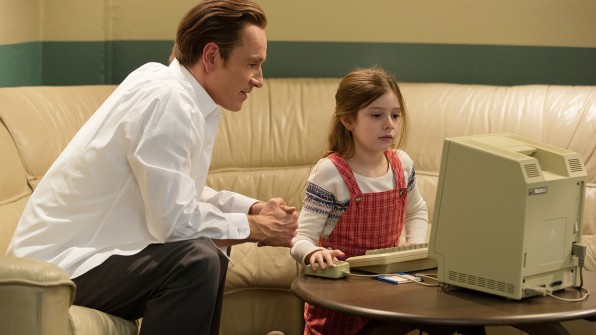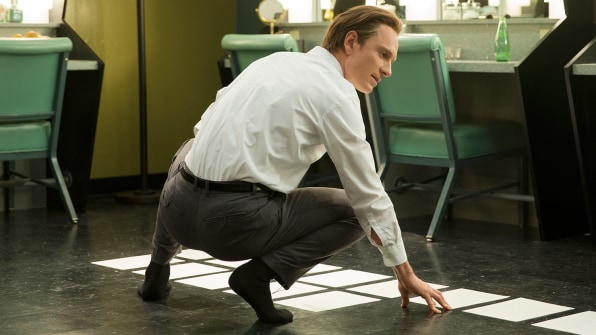Funny Memes Steve Jobs I Dont Want to Start Any Trouble but
Steve Jobs, the new movie from screenwriter Aaron Sorkin and director Danny Boyle, opens widely today. Its energetic, crackling direction showcases the kind of whiplash dialogue that Sorkin is famous for. Film critics have already started weighing in, with mostly positive reviews. Theatergoers will get their chance to watch the film today. The one thing they won't get is a chance to see a movie that's actually about Steve Jobs.
The movie plays fast and furious with the facts of the short life of the Apple cofounder (it opens four days after the fourth anniversary of his death). That's not something the filmmakers are trying to hide—indeed, Sorkin has proudly admitted that the facts have been altered in order to create a full character portrait.
So what kinds of fiction await moviegoers? Here are eleven to look out for:
1) In the opening scene, set during the moments before the January 24, 1984 introduction of Macintosh, the computer won't say "hello" in its robotic voice. Feeling that this glitch might ruin the launch, Jobs berates the Mac's programming genius, Andy Hertzfeld, threatening to announce Hertzfeld's failure from the stage if he doesn't solve the problem in the 40 minutes left before launch. As was true for all Apple product launches, preparation was demanding. But nothing resembling this scene happened on the day of the event.
2) Mac marketing director Joanna Hoffman discovers only on the day of the Mac's launch that the computer is a closed system, and that special tools are required to open up the case. The Mac team, of course, knew this well in advance of the launch.
3) Five-year-old Lisa Brennan, the daughter whose paternity Jobs originally denied, shows up with her mother Chrisann for the launch of the Mac. While waiting backstage for the event, she draws on the Mac using MacPaint, an "abstract" painting that endears her to her dad, who then decides to give more money to Chrisann. Pure fiction.

4) At the launch, the 1984 ad is introduced by Apple's Mike Markkula. In fact, Jobs himself introduced the ad.
5) In the second scene, set before the October 12, 1988 debut of NeXT's "black box" computer, Jobs tells Joanna Hoffman that Apple is "suing me." Apple did sue Jobs, but that was way back in 1985, shortly after he left the company to start NeXT with five key Apple renegades. Apple withdrew the suit in early 1986.
6) In a hallway backstage, Jobs tells Joanna Hoffman that he has a diabolical master plan: He will use NeXT (indeed, he will ensure its failure) to create an operating system that Apple will have to buy for half a billion dollars, giving him control of the company he founded. Jobs did have a chip on his shoulder about Apple, and the NeXT operating system did lead him back to Apple. But in 1988, he had no reason to believe that this could–much less would–happen.
7) In the last scene of the movie, set before the May 6, 1998 launch of the iMac, Jobs is described as a multi-billionaire. Jobs didn't get that kind of money until Disney bought Pixar, a company that's not even mentioned in the movie.
8) That last scene hinges on an imagined reconciliation with Lisa, and depends on an astounding fiction of omission: The entire scene takes place as if Jobs is unmarried, has no kids, and hasn't changed at all as a result. In fact, Jobs married Laurene Powell in 1991. They had three children, Reed (1991), Erin (1995), and Eve (1998). And Lisa lived with Steve and Laurene from 1992 to 1996.
9) After delivering some extremely optimistic sales forecasts for the iMac to Jobs, Hoffman says, "Steve, it's over, you win." While the iMac helped stabilize Apple, it didn't guarantee Steve's "victory." Apple was still losing money, and didn't start growing again until the early 2000s, after the surprising success of the iPod.
10) Apple cofounder Steve Wozniak and Jobs have a dramatic public shouting match before the iMac launch. Pure invention. By this time, Woz had already withdrawn from active work at Apple and the real blowup was long behind them. Talk about a one-dimensional character: Woz shows up in every act, begging for the same thing–he wants Jobs to publicly acknowledge the Apple II team, the one Woz led and that Jobs slighted. It's a thankless role. In this strange way, the movie is as unfair to Woz as it is to Jobs–which is ironic, given that Woz was a paid consultant.
11) Before each launch, Steve Wozniak, Hertzfeld, Apple CEO John Sculley, Chrisann Brennan, and Lisa Brennan-Jobs show up to confront Steve Jobs. This invention is the key to Sorkin's screenplay, a way of dramatically collecting and connecting all the players in Jobs's life. While some of these people did attend certain of these product launches, they did not attend all of them. As Jobs tells Hoffman in the movie, "It's like five minutes before every launch everyone goes to the bar and then tells me what they really think of me." A funny line, but almost certainly fictional.
As Sorkin told the Wall Street Journal, when asked about some of the movie's most memorable lines of dialogue, "If any of them are real, it's a remarkable coincidence."

See Fast Company Executive Editor Rick Tetzeli talk about Steve Jobs's real talent:
Source: https://www.fastcompany.com/3052092/steve-jobs-the-movie-11-things-that-arent-true-about-the-apple-co-founder
0 Response to "Funny Memes Steve Jobs I Dont Want to Start Any Trouble but"
Enregistrer un commentaire